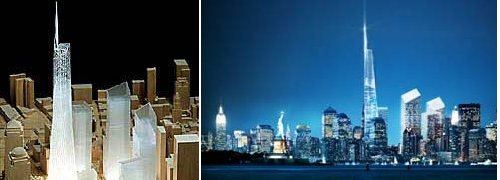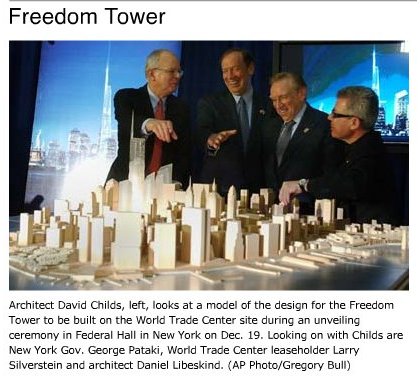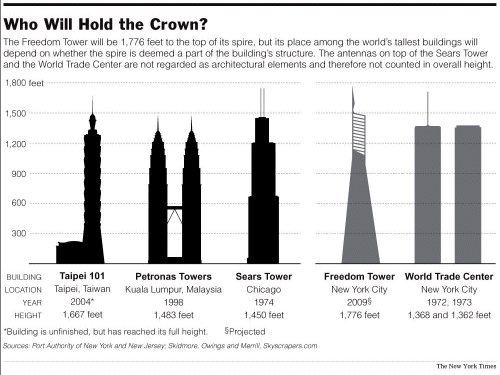December 21, 2003
New York’s Planned "Freedom Tower" Unveiled Amid Uncertainties Over Tallest Building Designation

This week’s unveiling of the 1,776-foot-tall "Freedom Tower" called into question the designation process for whether the proposed tower really will be the world's tallest, assuming it’s ever built. Despite repeated claims yesterday that it would be, the New York Times speculates the organization that bestows that honor might not think the latticework wind farm on top counts as part of a "habitable building." That’s got a few people annoyed: "The world's tallest building moniker is a shibboleth of feel-good boosterism perpetrated by rebuilding officials who have nothing else to offer the public but a P.R. campaign."
-
New York officials Friday unveiled final plans for the Freedom Tower, a shimmering skyscraper of glass, cable and steel rising over the World Trade Center site that will be the world's tallest building.

Gov. George E. Pataki hailed the sleek, twisting structure - whose angular, upward slope echoes the Statue of Liberty - as "a major step forward in the rebuilding of New York" after the Sept. 11, 2001, terrorist attack. He also praised the blueprint as a "stirring collaboration" between two prestigious architects who, until recently, had been feuding over their roles in the project.
Plans for the new commercial building were revealed during a brief ceremony at Federal Hall in Lower Manhattan, where George Washington was first sworn in as president and where the first U.S. Congress met. Officials repeatedly invoked the symbolism of the building, noting that the Freedom Tower would soar 1,776 feet into the air.
The building, which will sit at the northwest corner of the 16-acre World Trade Center site, will "dramatically reclaim a part of the New York skyline that we all lost on 9/11," Mayor Michael R. Bloomberg said. He suggested that the five-building complex planned for the site could be completed in 10 years.
Although officials selected a plan in February to develop the site, it has since undergone some crucial modifications - most notably the construction of a glass-and-concrete addition above the tower's commercial floors. The winning design for a memorial to victims of the terrorist attack will be announced separately next month.
Architects Daniel Libeskind and David M. Childs, who designed the Freedom Tower, described it Friday as an expression of public art that, like the memorial to be built at Ground Zero, would send a message about American freedom to future generations. The crucial element, they said, was building something that would stand the test of time.
"To join the vision of this structure to the image of the Statue of Liberty is quite a statement," said Libeskind, who as a child of immigrant parents sailed into New York Harbor years ago. "This building will rise to the height of 1,776 feet and it must never be surpassed, because that number truly means something to us all."
But developer Larry Silverstein - who holds a lease to operate the World Trade Center - said the thing that mattered most to him was that the Freedom Tower work economically, spurring development throughout Lower Manhattan.
He voiced confidence that the new building would lure a multitude of tenants back to the area, and said he had promised Pataki that the cornerstone for the Freedom Tower would be laid next year before the third anniversary of the attack.
"What we see here today is beautiful and spectacular, something to be very proud of," Silverstein said. "But I am happy to say that it is also very practical."
Silverstein, who previously had expressed unhappiness with what he called commercially unrealistic plans to redevelop the site, said the Freedom Tower's safety measures would vastly outpace those of the original twin towers and would include better-protected stairwells, blast-resistant glaze on lobby glass and better interior alarm systems.
The design calls for 70 commercial stories with 2.6 million square feet of office space, plus an underground regional transit hub, garages and several retail shopping centers. There also will be a public observation deck and a rebuilt Windows on the World, the restaurant that once sat atop the north tower. In the attack on the World Trade Center, 11 million square feet of office space was lost.
Although the previous World Trade Center buildings each had 110 stories, the Freedom Tower will rise higher because of a large glass structure and 276-foot spire topping off the building. Childs noted that special wind turbines would be constructed, allowing the building to generate 20% of its own energy needs.
The upbeat mood of Friday's unveiling belied months of behind-the-scenes disputes, both artistic and political.
Although Libeskind's master plan was selected this year to guide overall development of the site, Silverstein and others brought in Childs, a consulting design partner at Skidmore, Owings & Merrill, to help sharpen Libeskind's blueprint and turn his vision into a concrete plan.
The two architects reportedly clashed during recent months over issues involving the building's height and overall design, causing Libeskind to complain that he had been pressured into a "forced marriage." Pataki, who was determined to meet a December deadline for the unveiling, brokered a compromise that retained key elements of both plans and kept the work on schedule.
There also have been tensions between Pataki and Bloomberg over who should control the city's biggest public works project since the end of World War II. When the moment came Friday to pull the drawstrings on a white curtain and reveal the Freedom Tower design, the governor and the mayor reached awkwardly over each other to grab the cord, along with Childs, Libeskind and Silverstein.
"That's collaboration for you," the mayor said dryly.
There was little official disagreement, however, over the Freedom Tower's design.
Libeskind's trademark spire, reaching into space and topping off the building at 1,776 feet, was retained in the final blueprint; Childs' key contribution was the cabled glass and steel section atop the commercial floors that is meant to recall the design of the Brooklyn Bridge and serve as a symbol of American energy and ingenuity.
Officials said the building would stand directly opposite a memorial to victims of the terrorist attack and complement it in subtle ways. A key feature of the Freedom Tower, Childs said, was that its design would "split and confuse" the strong winds that often blow through the area from the Hudson River, thus offering "protection" from the elements to millions of people visiting the memorial.
As for whether it’s the tallest building in the world, there are plenty of people who might argue with the designation. Just take a look at the graphic below that compares various designs.

Another piece in the New York Times discusses the politics of highest-building designations:
-
It will certainly be the world's tallest cable-framed, open-air, windmill-filled, spire-studded superstructure, rising atop 70 stories of offices, restaurants, a broadcast center and an observation deck.
Whether that makes it the world's tallest building is another matter. No fewer than a half-dozen times at the unveiling yesterday, the Freedom Tower at the World Trade Center site was called the world's tallest building.
But the Council on Tall Buildings and Urban Habitat, a recognized arbiter, has not yet ruled. And it may be a tough group to persuade. That is because the Freedom Tower will be a hybrid structure with several pinnacles: the top of its enclosed, occupied space is to be at about 1,150 feet; the top of the superstructure at 1,500 feet; and the top of its slender spire at 1,776 feet.
In other words, about one-third of the Freedom Tower will be more of a structural framework than a habitable building. "There are strong feelings on both sides of this," said Ron Klemencic, a structural engineer in Seattle and the chairman of the tall buildings council, which is affiliated with the Illinois Institute of Technology in Chicago. "There's a camp that would say that since so much of the structure is not available to be occupied, it should not be considered the tallest building in the world," he said in a telephone interview on Thursday.
Never mind the Freedom Tower - you can get an argument today about just what is the world's tallest building, even after disallowing cable-supported broadcast towers and agreeing not to count rooftop antennas.
The CN Tower in Toronto unhesitatingly describes itself as the world's tallest building, at 1,815 feet. But some see it is as more of a mast, with a relatively small amount of occupied space. To the council, it is the tallest free-standing structure in the world.
Then comes Taipei 101, a 101-story tower nearing completion in Taiwan, at 1,667 feet, with the top occupied floor at 1,470 feet. The council is inclined to award it the tallest designation, Mr. Klemencic said, but not until it is available for occupancy sometime in late 2004.
That leaves as the reigning champion the 88-story twin Petronas Towers in Kuala Lumpur, Malaysia, which measure 1,483 feet at the top of their spires but only 1,229 feet at their top occupied floors.
The fact that the bulk of these towers is lower than the Sears Tower in Chicago (1,450 feet over all but occupied to 1,431 feet) gave the council pause.
But it decided to recognize spires as the "top of the architecture"; that is, a feature without which the building would look fundamentally different.
Paradoxically, Mr. Klemencic said, the "top of the architecture" criterion had been proposed by an earlier council chairman, Fazlur R. Khan, the engineer at Skidmore, Owings & Merrill who was largely responsible for the Sears Tower. The Skidmore firm is in competition with itself in the perpetual world's-tallest race, since it is also designing a project known as Burj Dubai in Dubai.
Another contender is the Shanghai World Financial Center by Kohn Pedersen Fox Associates of New York.
Whatever it is that Freedom Tower turns out to be the tallest of, in other words, it may not be for long.
- Arik
Posted by Arik Johnson at December 21, 2003 03:46 PM | TrackBack "Competitive Intelligence applies the lessons of competition and principles of intelligence to the need for every business to gain awareness and predictability of market risk and opportunity. By doing so, CI has the power to transform an enterprise from also-ran into a real winner, with agility enough to create and maintain sustainable competitive advantage."
"Competitive Intelligence applies the lessons of competition and principles of intelligence to the need for every business to gain awareness and predictability of market risk and opportunity. By doing so, CI has the power to transform an enterprise from also-ran into a real winner, with agility enough to create and maintain sustainable competitive advantage."
